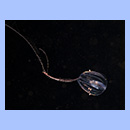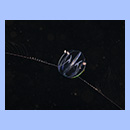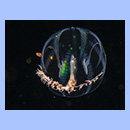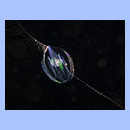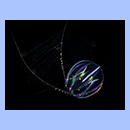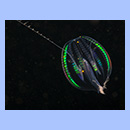- Kingdom: Animalia
- Phylum: Ctenophora
- Class: Tentaculata
- Order: Cydippida
- Family: Pleurobrachiidae
- Scientific name: Pleurobrachia pileus
- Norwegian: sjøstikkelsbær
Characteristics:
The transparent body is spherical or slightly oval with a maximum diameter of 25 mm. It has eight rows of ciliary plates, used for propulsion. These "comb rows" are generating the beautiful color reflections often associated with the comb jellies.
Despite its delicate and perhaps innocent appearance, the sea gooseberry is a voracious predator. Two tentacles, sometimes reaching a length of 20 times the body diameter, are used to catch prey floating by. It feeds on eggs, and larvae, small mollusks, arthropods and almost anything else, it can get hold of. They can be retracted into pockets inside its body, but the sea gooseberry is often seen spinning around its own center, twirling the tentacles around its body. On each tentacle there is a lateral row of fine filaments with a sticky substance, to make sure the prey is not getting loose. In contrast to the jelly fish, the comb jellies have no poison to paralyze their victims.
The sea gooseberry is a hermaphrodite, it possesses both male and female genitalia. Eggs and sperms are released into the water, where the fertilization occurs.
Habitat:
It inhabits shallow waters, from the surface to a rare maximum of 200 meters.
Distribution:
The sea gooseberry is a cosmopolitan, found in almost every ocean in the world.
